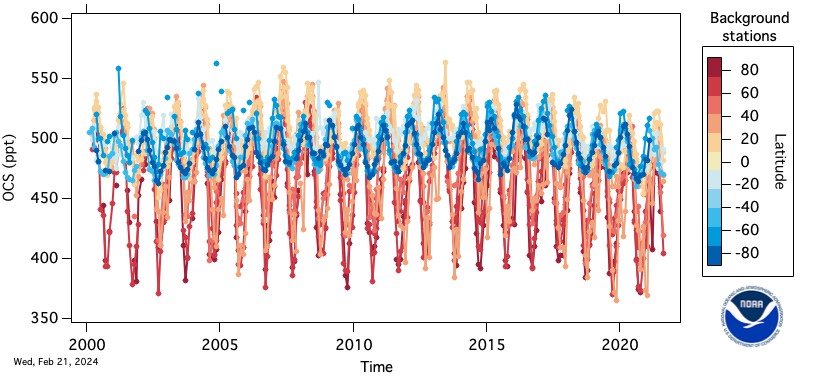Carbonyl Sulfide (OCS or COS)
There are two GML programs that measure OCS. The longest and most complete measurement of OCS is from the HATS flask program (data displayed below). The CATS in situ GCs also measure OCS, however the data are much less precise than the flask measurements.

Atmospheric dry mole fractions (parts-per-trillion or ppt) of OCS measured by GC-MSD in the HATS flask program. Each point represents a monthly mean at one of 8-12 stations: Alert, Canada (ALT), Summit Greenland (SUM), Barrow, Alaska (BRW), Mace Head, Ireland (MHD), Trinidad Head, California (THD), Niwot Ridge, Colorado (NWR), Cape Kumukahi, Hawaii (KUM), Manua Loa, Hawaii (MLO), American Samoa (SMO), Cape Grim, Australia (CGO), Palmer Station, Antarctica (PSA), South Pole, Antarctica (SPO).

Zonal mean dry mole fractions (ppt) are estimated from the flask program by equally weighting monthly mean measurements in each latitude band. Small gaps (less than 6 months) are interpolated prior to averaging. Solid lines are used for Northern hemispheric measurements and dashed for the Southern hemisphere.
Selected Publications
- Hu, L., S. Montzka, A. Kaushik, A. Andrews, C. Sweeney, J. Miller, I. Baker, S. Denning, E. Campbell, Y. Shiga, P. Tans, M. C. Siso, M. Crotwell, K. McKain, K. Thoning, B. Hall, I. Vimont, J. Elkins, M. Whelan, P. Suntharalingam (2021), COS-derived GPP relationships with temperature and light help explain high-latitude atmospheric CO2 seasonal cycle amplification, Proc. Natl. Acad. Sci. U.S.A., 118(33): e2103423118. http://doi.org/10.1073/pnas.2103423118.
Data used to derive fluxes in Hu, et al. 2021 paper are located here. - Montzka, S. A., P. Calvert, B. D. Hall, J. W. Elkins, T. J. Conway, P. P. Tans, and C. Sweeney (2007), On the global distribution, seasonality, and budget of atmospheric carbonyl sulfide (COS) and some similarities to CO2, J. Geophys. Res., 112, D09302, doi:10.1029/2006JD007665.
- Montzka, S. A., M. Aydin, M. Battle, J. H. Butler, E. S. Saltzman, B. D. Hall, A. D. Clarke, D. Mondeel, and J. W. Elkins (2004), A 350-year atmospheric history for carbonyl sulfide inferred from Antarctic firn air and air trapped in ice, J. Geophys. Res., 109, D22302, doi:10.1029/2004JD004686.
